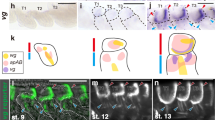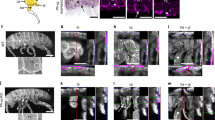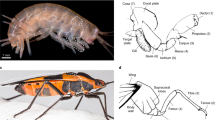Abstract
The two pairs of wings that are characteristic of ancestral pterygotes (winged insects) have often undergone evolutionary modification. In the fruitfly, Drosophila melanogaster, differences between the membranous forewings and the modified hindwings (halteres) depend on the Hox gene Ultrabithorax (Ubx). The Drosophila forewings develop without Hox input, while Ubx represses genes that are important for wing development, promoting haltere identity1,2. However, the idea that Hox input is important to the morphologically specialized wing derivatives such as halteres, and not the more ancestral wings, requires examination in other insect orders. In beetles, such as Tribolium castaneum, it is the forewings that are modified (to form elytra), while the hindwings retain a morphologically more ancestral identity. Here we show that in this beetle Ubx ‘de-specializes’ the hindwings, which are transformed to elytra when the gene is knocked down. We also show evidence that elytra result from a Hox-free state, despite their diverged morphology. Ubx function in the hindwing seems necessary for a change in the expression of spalt, iroquois and achaete-scute homologues from elytron-like to more typical wing-like patterns. This counteracting effect of Ubx in beetle hindwings represents a previously unknown mode of wing diversification in insects.
This is a preview of subscription content, access via your institution
Access options
Subscribe to this journal
Receive 51 print issues and online access
$199.00 per year
only $3.90 per issue
Buy this article
- Purchase on Springer Link
- Instant access to full article PDF
Prices may be subject to local taxes which are calculated during checkout



Similar content being viewed by others
References
Lewis, E. B. A gene complex controlling segmentation in Drosophila. Nature 276, 565–570 (1978)
Weatherbee, S. D., Halder, G., Kim, J., Hudson, A. & Carroll, S. Ultrabithorax regulates genes at several levels of the wing-patterning hierarchy to shape the development of the Drosophila haltere. Genes Dev. 12, 1474–1482 (1998)
Carroll, S. B., Weatherbee, S. D. & Langeland, J. A. Homeotic genes and the regulation and evolution of insect wing number. Nature 375, 58–61 (1995)
Struhl, G. Genes controlling segmental specification in the Drosophila thorax. Proc. Natl Acad. Sci. USA 79, 7380–7384 (1982)
Weatherbee, S. D. et al. Ultrabithorax function in butterfly wings and the evolution of insect wing patterns. Curr. Biol. 9, 109–115 (1999)
Warren, R. W., Nagy, L., Selegue, J., Gates, J. & Carroll, S. Evolution of homeotic gene regulation and function in flies and butterflies. Nature 372, 458–461 (1994)
Kelsh, R., Weinzierl, R. O., White, R. A. & Akam, M. Homeotic gene expression in the locust Schistocerca: an antibody that detects conserved epitopes in Ultrabithorax and abdominal-A proteins. Dev. Genet. 15, 19–31 (1994)
Curtis, C. D. et al. Molecular characterization of Cephalothorax, the Tribolium ortholog of Sex combs reduced. Genesis 30, 12–20 (2001)
Beeman, R. W. A homeotic gene cluster in the red flour beetle. Nature 327, 247–249 (1987)
Beeman, R. W., Stuart, J. J., Haas, M. S. & Denell, R. E. Genetic analysis of the homeotic gene complex (HOM-C) in the beetle Tribolium castaneum. Dev. Biol. 133, 196–209 (1989)
Brown, S. J. et al. Sequence of the Tribolium castaneum homeotic complex: the region corresponding to the Drosophila melanogaster Antennapedia complex. Genetics 160, 1067–1074 (2002)
Stuart, J. J., Brown, S. J., Beeman, R. W. & Denell, R. E. A deficiency of the homeotic complex of the beetle Tribolium. Nature 350, 72–74 (1991)
Bennett, R. L., Brown, S. J. & Denell, R. E. Molecular and genetic analysis of the Tribolium Ultrabithorax ortholog, Ultrathorax. Dev. Genes Evol. 209, 608–619 (1999)
Tomoyasu, Y. & Denell, R. E. Larval RNAi in Tribolium (Coleoptera) for analyzing adult development. Dev. Genes Evol. 214, 575–578 (2004)
Lorenzen, M. D. et al. piggyBac-mediated germline transformation in the beetle Tribolium castaneum. Insect Mol. Biol. 12, 433–440 (2003)
El-Kifl, A. H. Morphology of the adult Tribolium confusum Duv. and its differentiation from Tribolium (stene) castaneum Herbst. Bull. Soc. Fouad 1er Entom. 37, 173–249 (1953)
de Celis, J. F., Barrio, R. & Kafatos, F. C. A gene complex acting downstream of dpp in Drosophila wing morphogenesis. Nature 381, 421–424 (1996)
Sanchez-Salazar, J. et al. The Tribolium decapentaplegic gene is similar in sequence, structure, and expression to the Drosophila dpp gene. Dev. Genes Evol. 206, 237–246 (1996)
Grimm, S. & Pflugfelder, G. O. Control of the gene optomotor-blind in Drosophila wing development by decapentaplegic and wingless. Science 271, 1601–1604 (1996)
Gomez-Skarmeta, J. L., Diez del Corral, R., de la Calle-Mustienes, E., Ferre-Marco, D. & Modolell, J. araucan and caupolican, two members of the novel iroquois complex, encode homeoproteins that control proneural and vein-forming genes. Cell 85, 95–105 (1996)
Wheeler, S. R., Carrico, M. L., Wilson, B. A., Brown, S. J. & Skeath, J. B. The expression and function of the achaete-scute genes in Tribolium castaneum reveals conservation and variation in neural pattern formation and cell fate specification. Development 130, 4373–4381 (2003)
Campuzano, S. et al. Molecular genetics of the achaete-scute gene complex of D. melanogaster. Cell 40, 327–338 (1985)
Sturtevant, M. A., Biehs, B., Marin, E. & Bier, E. The spalt gene links the A/P compartment boundary to a linear adult structure in the Drosophila wing. Development 124, 21–32 (1997)
de Celis, J. F. & Barrio, R. Function of the spalt/spalt-related gene complex in positioning the veins in the Drosophila wing. Mech. Dev. 91, 31–41 (2000)
Abouheif, E. & Wray, G. A. Evolution of the gene network underlying wing polyphenism in ants. Science 297, 249–252 (2002)
Beeman, R. W., Brown, S. J., Stuart, J. J. & Denell, R. E. in Molecular Insect Science (eds Hagedorn, H. H., Hildebrannd, J. G., Kidwell, M. G. & Law, J. H.) 21–29 (Plenum, New York, 1990)
Beeman, R. W. & Stauth, D. M. Rapid cloning of insect transposon insertion junctions using ‘universal’ PCR. Insect Mol. Biol. 6, 83–88 (1997)
Quennedey, A. & Quennedey, B. Morphogenesis of the wing anlagen in the mealworm beetle Tenebrio molitor during the last larval instar. Tissue Cell 22, 721–740 (1990)
Acknowledgements
We thank G. Bucher, M. Weber and M. Klingler for the pu11 enhancer-trap line, R. White for the FP6.86 antibody, DSHB for the 4D9 antibody and G. Pflugfelder for sharing information about omb degenerate primers. We thank K. Leonard for maintaining beetle stocks, T. Shippy for discussion and reading and S. Brown, R. Beeman, S. Haas and all the Manhattan beetle/insect laboratory members for discussion and comments. Y.T. thanks A. Sato and T. Yamaguchi for discussion. This work was supported by the international Human Frontier Science Program Organization (Long-term Fellow) and the National Science Foundation.
Author information
Authors and Affiliations
Corresponding author
Ethics declarations
Competing interests
The authors declare that they have no competing financial interests.
Supplementary information
Supplementary Figure 1
Detailed structures of elytra from wild-type, Cx RNAi (T1), and Utx RNAi (T3) adults. (PDF 107 kb)
Supplementary Figure 2
Transformed dorsal structures of Utx and ptl RNAi beetles. (PDF 85 kb)
Supplementary Figure 3
Relationship of Tc-iro stripes to the A/P boundary in the wing disc. (PDF 76 kb)
Rights and permissions
About this article
Cite this article
Tomoyasu, Y., Wheeler, S. & Denell, R. Ultrabithorax is required for membranous wing identity in the beetle Tribolium castaneum. Nature 433, 643–647 (2005). https://doi.org/10.1038/nature03272
Received:
Accepted:
Issue Date:
DOI: https://doi.org/10.1038/nature03272
This article is cited by
-
A Micro-evolutionary Change in Target Binding Sites as a Key Determinant of Ultrabithorax Function in Drosophila
Journal of Molecular Evolution (2023)
-
The red flour beetle T. castaneum: elaborate genetic toolkit and unbiased large scale RNAi screening to study insect biology and evolution
EvoDevo (2022)
-
The transcription factor Zfh1 acts as a wing-morph switch in planthoppers
Nature Communications (2022)
-
Glucosamine-6-phosphate N-acetyltransferase gene silencing by parental RNA interference in rice leaf folder, Cnaphalocrocis medinalis (Lepidoptera: Pyralidae)
Scientific Reports (2022)
-
Panarthropod tiptop/teashirt and spalt orthologs and their potential role as “trunk”-selector genes
EvoDevo (2021)
Comments
By submitting a comment you agree to abide by our Terms and Community Guidelines. If you find something abusive or that does not comply with our terms or guidelines please flag it as inappropriate.



